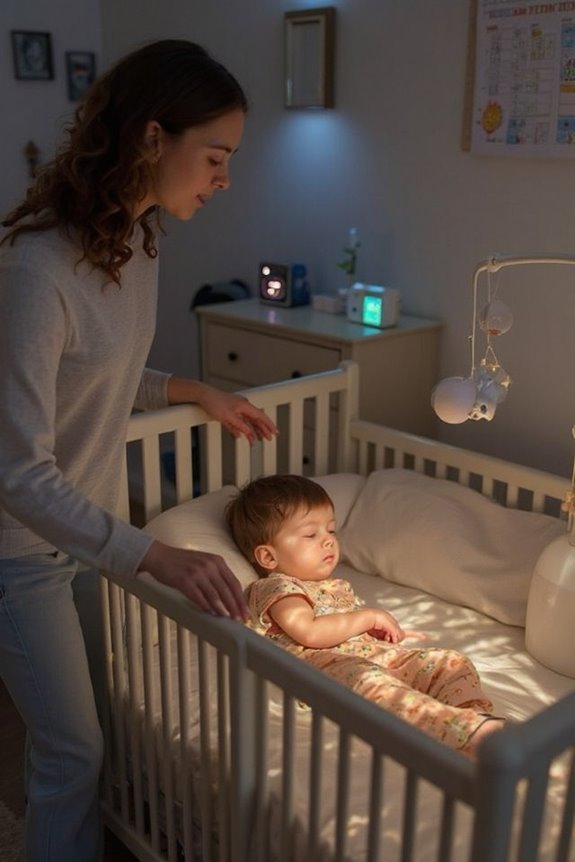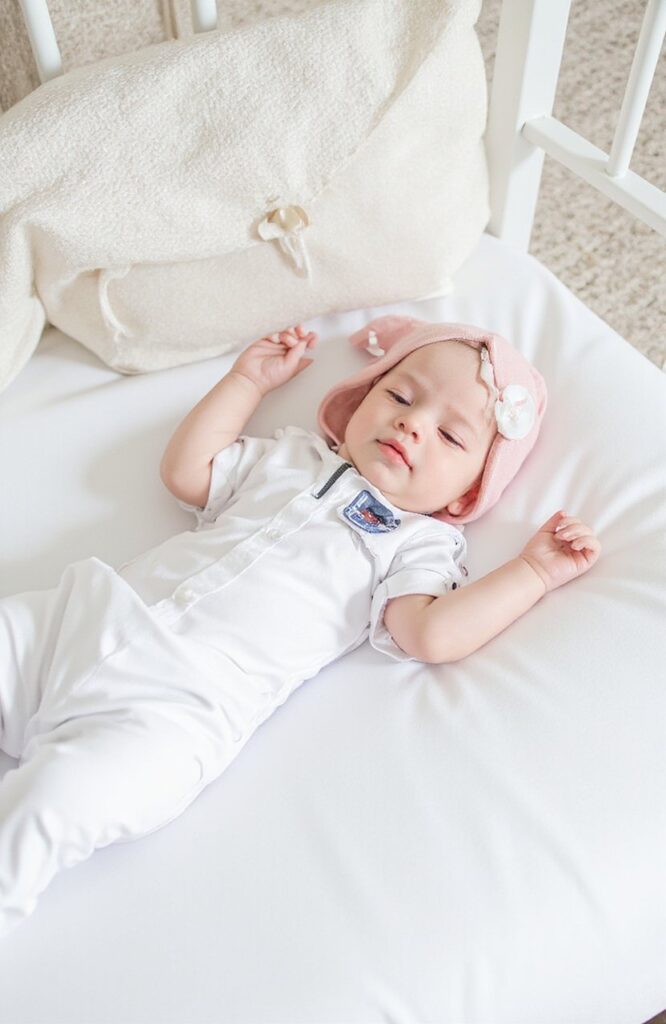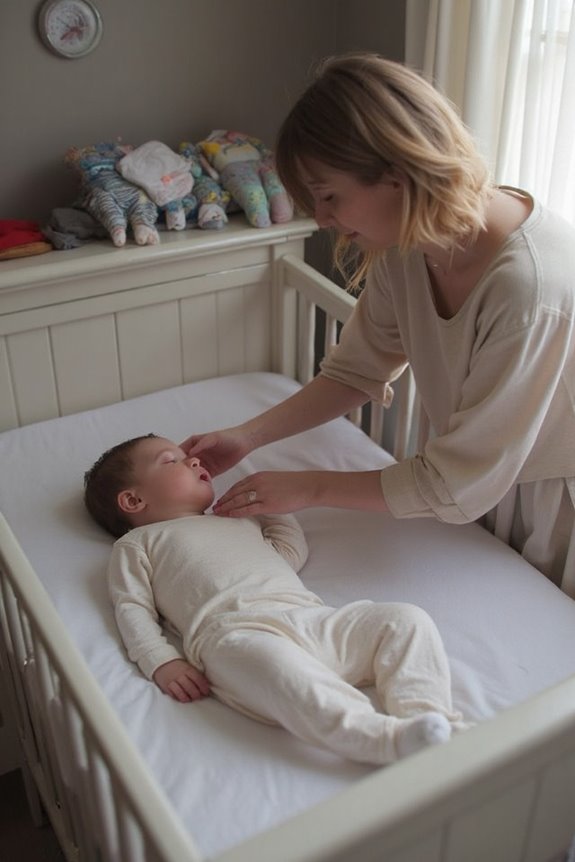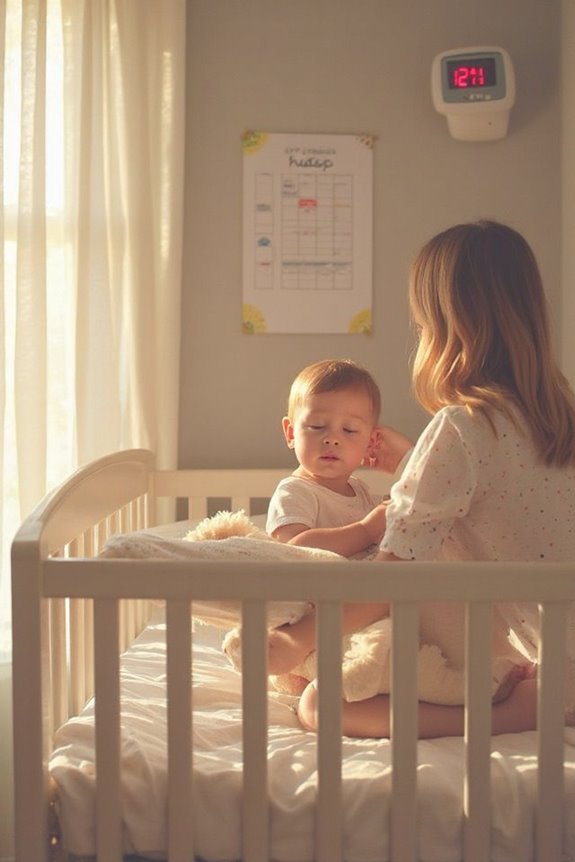To help your baby sleep in their crib, guarantee it’s safe with a firm mattress and no loose items. Establish a consistent bedtime routine before 9 PM with calming activities like baths and stories. Shift gradually by starting with daytime naps, then reducing physical contact over time. Address challenges by checking for discomfort, maintaining a 68-72°F room temperature, and using white noise. Track sleep patterns to make informed adjustments as your baby develops self-soothing skills.
Key Takeaways
- Create a consistent bedtime routine with calming activities like baths, stories, or lullabies before 9 PM.
- Ensure the crib has a firm mattress with no gaps, proper slat spacing, and remove all pillows, blankets, and toys.
- Gradually transition baby to the crib by starting with daytime naps and slowly reducing physical contact.
- Maintain optimal sleep conditions with room temperatures between 68-72°F, white noise, and blackout curtains.
- Allow brief periods of mild crying to encourage self-soothing skills while monitoring sleep patterns.
Creating a Safe and Comfortable Crib Environment
When it comes to your baby’s sleep space, safety must be your top priority. I recommend starting with a firm mattress that fits snugly in the crib—there shouldn’t be gaps larger than two fingers between the mattress and crib sides.
For ideal crib safety:
- Verify slats are no more than 2⅜ inches apart
- Keep the sleep environment completely bare except for a tight-fitting sheet
- Remove all pillows, blankets, and stuffed toys
- Regularly check for loose hardware or damaged parts
Maintain a comfortable temperature by dressing your baby in one more layer than you’d wear. Consider using a sleep sack instead of blankets for warmth. Remember to place your baby on their back every time—this position considerably reduces SIDS risk.
Establishing a Consistent Bedtime Routine

Now that your baby has a safe sleep environment, let’s focus on helping them actually fall asleep in it. Implementing a regular bedtime routine offers significant bedtime benefits for both you and your little one:
- Helps regulate your baby’s internal clock
- Reduces the time it takes for them to fall asleep
- Decreases night wakings
- Improves your mood as a parent
For best results:
- Start your routine before 9 PM
- Repeat it at least five nights weekly
- Include calming activities (bath, story, lullaby)
While consistency is essential, routine flexibility allows you to accommodate occasional schedule changes. Remember that a consistent routine doesn’t mean rigid—it means predictable. Your baby will learn to recognize sleep cues, making crib shifts smoother and improving everyone’s quality of rest.
Gradual Transition Techniques for Crib Sleeping
Shifting your baby to crib sleeping doesn’t have to happen overnight. I recommend using familiarization techniques first – spend daytime hours in the nursery so your baby associates the space with comfort.
Consider these proven approaches:
- Start with the first nap of the day when sleep pressure is highest
- Implement physical contact reduction gradually over days or weeks
- Try the chair method by sitting beside the crib, then slowly moving the chair farther away each night
- Maintain predictability importance by keeping change schedules consistent
Remember to observe your baby’s responses and adjust accordingly. The change period varies for each child, but consistency is key. These gradual methods help minimize stress while building your baby’s confidence in independent sleeping.
Addressing Common Crib Sleeping Challenges
Even after establishing a gradual crib shift, many parents face ongoing challenges with their baby’s sleep. When your little one experiences a sleep regression, you’ll notice more frequent night wakings and increased fussiness. These temporary disruptions often coincide with developmental milestones.
If your baby is crying in the crib, consider these crying solutions:
- Check for medical issues, soiled diapers, or hunger needs
- Confirm room temperature stays between 68-72°F
- Use white noise to mask disruptive sounds
- Maintain darkness with blackout curtains
- Allow brief periods of mild crying as they learn to self-soothe
Remember that consistent routines help babies associate their crib with sleep. If crying persists beyond a few minutes, gently reassure your baby while maintaining your sleep training approach. Most crib challenges resolve as your baby adapts to their sleep environment.
Monitoring and Adjusting Your Baby’s Sleep Progress

Once you’ve established initial crib sleeping habits, monitoring your baby’s sleep patterns becomes crucial for long-term success. I recommend maintaining detailed sleep logs to track your baby’s progress over time, noting:
- Total sleep duration
- Number of night wakings
- Self-soothing instances
- Nighttime interventions needed
Tracking these sleep metrics allows you to identify patterns and make data-driven adjustments to your approach. If your baby struggles with certain aspects of crib sleeping, consider gradual modifications to your strategy rather than complete overhauls.
Be consistent with any changes you implement, but remain flexible as your baby develops. Remember that sleep needs evolve with age and developmental milestones. Regular evaluation of your strategy guarantees you’re adapting appropriately to support your baby’s growing independence in the crib.
Frequently Asked Questions
When Should I Transition My Baby From Bassinet to Crib?
I’d shift your baby from bassinet to crib around 4 months, or when they reach the weight limit (10-45 pounds). Watch for shift signs like rolling over, increased mobility, and sleeping through the night.
Can I Use Crib Bumpers to Prevent My Baby Hitting Their Head?
I don’t recommend crib bumpers for head injury prevention. They pose serious suffocation risks that outweigh any benefits. Modern cribs have safe slat spacing, and a bare crib is the safest sleep environment for your baby.
Should I Wake My Baby for Feedings When They’re Sleeping Well?
Let sleeping babies lie like undisturbed water. I don’t recommend waking a sleeping baby for feedings unless medically advised. Their natural baby sleep patterns typically guide feeding schedules, especially once they’re gaining weight appropriately.
How Do I Handle Nighttime Diaper Changes Without Fully Waking Baby?
I’ve found incorporating diaper changes into your nighttime routine works best. Use low lighting, warm wipes, and quick diaper change techniques. Keep movements gentle and minimize talking to help your baby stay drowsy throughout.
Is Co-Sleeping Ever Safe as an Alternative to Crib Sleeping?
With 9 in 10 parents co-sleeping at some point, I understand the appeal. While co-sleeping risks include increased SIDS danger, room-sharing is a safe alternative that keeps baby close while maintaining separate sleep surfaces.





